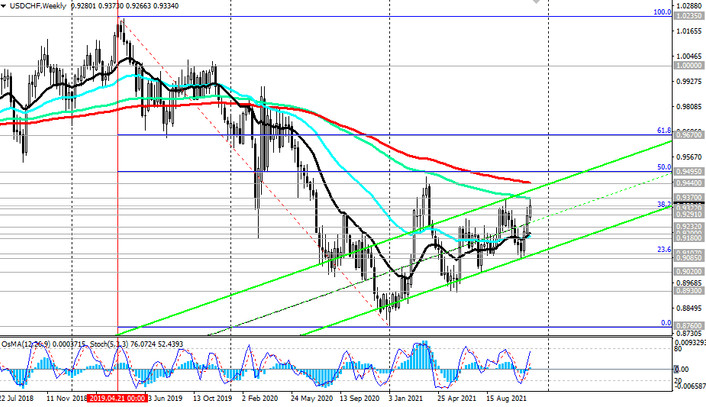As follows from the punctures of the November meeting published last Wednesday, the Fed leaders expressed increased concern about the persistence of increased inflation, and also discussed whether they need to prepare for an increase in interest rates in the first half of next year to cool the economy.
As you know, following the meeting that ended on November 3, the Fed leaders decided to reduce the volume of purchases of assets, which amounted to $ 120 billion a month, by $ 15 billion in November and December. In their view, such a cut, "is likely to be appropriate every month", although they are willing to adjust the pace of the curtailment of purchases, "if it is justified in view of changes in the outlook for the economy".
At a press conference, Jerome Powell reiterated that the central bank will not rush to raise interest rates, since the labor market has not yet fully recovered, and the Fed still considers increased inflation to be a temporary phenomenon.
The published minutes of the FOMC meeting also indicate that some Fed officials have signaled their concerns about expanding inflationary pressures and may want to wind down the stimulus program earlier if they feel an urgent need to raise interest rates. By the pace of winding down indicated at the November meeting, the Fed intends to complete the asset purchases by June next year, and then, if necessary, move on to raising rates.
Last week, Fed Board member Christopher Waller said that against the backdrop of a worsening inflation situation, he is beginning to consider it expedient to wind down quantitative easing and stimulus more quickly in 2022, and Fed Vice Chairman Richard Clarida said that he would "closely monitor the data that will be released from now until the December meeting". In his opinion, "it may be quite appropriate at that meeting to discuss the acceleration of the pace of reduction" of asset purchases.
From now on, market participants will closely follow the macro statistics coming from the US and new statements from the Fed on whether to accelerate the process of curtailing stimulus during the meeting, which will be held on December 14-15. If, after the December meeting, Fed leaders accelerate the pace of reduction in asset purchases, for example, to $ 30 billion a month, then the QE program may be completed by March, which will increase the likelihood of a rise in interest rates in the first half of next year.
Thus, the intrigue regarding the further actions of the FRS, and at the same time regarding the further dynamics of the dollar, is exacerbated.
Meanwhile, the dollar is holding on to its won positions. Despite the fact that futures on the DXY dollar index fell today from yesterday's new 16-month high 96.94, they remain positive and have the potential for further growth.
US durable goods orders such as home appliances, cars and computers fell for the second straight month in October (-0.5%), according to data released on Wednesday, as manufacturers continued to face higher prices for materials and transportation, as well as increasing labor costs and a shortage of components.
At the same time, other data also released on Wednesday was very positive.
Thus, according to a report by the US Department of Labor, the number of Americans who filed an initial application for unemployment benefits last week fell to their lowest level in 52 years, which indicates high demand for labor amid recovery in economic activity after the pandemic. The number of initial jobless claims for the week of November 14-20 fell by 71,000 to 199,000, the lowest since November 1969.
Household spending in October increased by 1.3%, while personal income increased by 0.5% compared to September. The Core Personal Consumption Expenditure Index (Core PCE) rose 4.1% year-on-year in October, the highest since 1991. This index is the Fed's preferred inflation indicator and excludes volatile food and energy prices.
US consumer spending rose in October, boosting the overall economic recovery while companies ramped up investment. With accelerating inflation, which has reached a 30-year high, other macro data indicate the continuing momentum of the recovery of the American economy, while the demand for labor is growing.
Earlier this week, US President Joe Biden's decision to appoint Jerome Powell as chairman of the Federal Reserve System (Biden also nominated Lael Brainard as vice chairman of the central bank) helped strengthen the dollar.
Thus, the new information received from the US this week on the situation in the American economy and on the sentiments among the FRS leaders regarding the prospects for monetary policy creates a favorable background for the further strengthening of the dollar.
On Thursday, US trading floors and banks are closed for Thanksgiving, and on Friday the US trading session will be shortened. The DXY dollar index has reached its highest levels since July 2020, and with no activity from US traders until the end of this week, the dollar is likely to maintain its strong position in the foreign exchange market.
Meanwhile, one of the important macro data to watch out for before the end of this week is the publication on Friday (at 08:00 GMT) of the State Secretariat of Economic Affairs report on Swiss GDP for the 3rd quarter. GDP is considered an indicator of the general state of a country's economy and estimates the rate of its growth or decline. The Gross Domestic Product Statement expresses in monetary terms the aggregate value of all final goods and services produced by Switzerland over a given period of time. A growing trend in GDP is considered a positive factor for the national currency (franc), while a low result is considered negative (or bearish).
In the previous 2nd quarter of 2021, GDP grew by +1.8% (+7.7% on an annualized basis) after falling by -0.5% in the 1st quarter (-0.5% on an annualized basis). It seems that the situation with the GDP and the economy of Switzerland is improving after their fall in the first half of 2020, although this decline is not comparable to the decline in GDP in Germany, the Eurozone and the United States, however, by a very uneven pace. Switzerland's GDP is projected to grow +3.2% (YoY) in the 3rd quarter of 2021. The data point to continued recovery in the Swiss economy, albeit at a slower pace, which is a positive factor for the franc.

If the data turn out to be weaker than the forecast, then the franc may decline in the short term. However, one should not expect a strong fall in the franc, as it is in active demand as a defensive asset. Better-than-expected data could strengthen the franc and weaken the USD / CHF in the short term. In the meantime, this currency pair is traded in the long-term bear market zone, below the key resistance levels 0.9370, 0.9440. The main tone in USD / CHF is currently set by the dollar, and in case of its further strengthening, it is also worth waiting for the growth of this currency pair. However, only the breakdown of the resistance levels 0.9440, 0.9495 will indicate its return into the zone of the long-term bull market.





